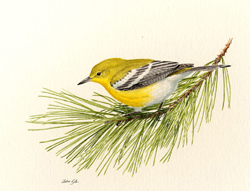Find a Bird - BBA1
Breeding Bird Atlas 1 Species Accounts
Pine Warbler
Dendroica pinus
Egg Dates
May 8 to late July
Number of Broods
one or two

The Pine Warbler is aptly named because for much of the year it seldom wanders far from pine woodlands. In the Pitch Pine barrens of Cape Cod and the Islands, a traditional stronghold, Pine Warblers are common and widespread throughout the summer. Their numbers diminish as sandy lands become valuable real estate and pines fall to the bulldozer. More rarely, pines yield to the natural succession of oaks, and breeding birds look elsewhere for favored habitat. There are good populations in southern Bristol and Plymouth counties, but north of this the species becomes very spotty and local in distribution. In recent years, Pine Warblers have increased in some sections of interior Massachusetts. There, the preferred tree is the White Pine. These birds are rare to absent at the higher elevations and in areas of deciduous forest.
The ragged Pitch Pine forest, an anathema to foresters, suits the Pine Warbler just fine. Sparse growth makes for sunny glades and sheltered clearings, and wind damage adds the insects of decay to the multitudinous pests of pines. The understory of Scrub Oak and huckleberry increases the variety of insect and vegetal food. The interior White Pine forest, with taller trees and little understory, is an altogether different type of habitat. Most characteristically, Pine Warblers work along trunks and branches, leisurely probing for eggs and larvae in bark crevices, extracting an inchworm from the needles, plucking a spider from its filament, and earning their other name of “Pine-creeping Warbler.”
The Pine Warbler is one of the earliest of migrant spring warblers. Because the birds winter in the southern third of the breeding range, the distance for spring migration is comparatively short. First arrivals in late March cheer the waking woods with a plangent trill. Massachusetts breeding birds are on territory by the third week of April, although migrants heading farther north continue into early May. Their passage takes them into orchards and deciduous thickets, but for nesting they seek conifers, usually the pines mentioned previously, but occasionally another type of pine and rarely Red Cedar or hemlock. They prefer not the deep, dark woods but rather the edges and openings.
The breeding male sings persistently. His is one of the least versatile of warbler songs, a changeless paean to the pines. While authorities disagree on the quality of the song, it is similar to that of the Chipping Sparrow but generally more musical, sweeter, slower, and softer. The Pine Warbler sings into summer, pausing during molt and singing again during warm autumn days. Call notes include a lisping seet and a soft chip. Rapid and insistent chipping is common during courtship and territory defense and is given also by begging young. Courting males may show some pugnacity.
Nests recorded in southeastern Massachusetts were all in Pitch Pines at heights of 10 to 25 feet and were saddled on horizontal limbs, generally hidden in clumps of needles but sometimes exposed. One nest near Mount Auburn Cemetery was located at 40 feet in a Red Cedar (ACB). Two recent Worcester County nests were, respectively, at 15 and 30 feet near the ends of White Pine branches (Meservey). The female uses weed stems, strips of bark, and pine needles bound with caterpillar or spider silk to construct the compact and well-made nest. A warm lining of plant down, hair, or feathers protects the three to five (usually four) eggs from early-season chill. Two females in Worcester County were observed nest building from May 3 to May 6 (Meservey). The eggs are smooth, not glossy, whitish, and speckled with shades of red-brown at the large end. The species is apparently seldom victimized by cowbirds. It may take 14 days for nest construction and the completion of the clutch. There are conflicting reports about the male’s assisting in incubation, but this task is probably performed mainly by the female. Both sexes tend the young. The incubation and nestling periods are unrecorded, but each probably averages about 12 days.
Nesting data for Massachusetts is very scanty. A pair was feeding nestlings on June 6 (Meservey), and adults feeding fledglings were observed on July 18 and August 24 (Nice 1933). The extended laying period indicates that there is also a wide range of dates for both nestlings and fledglings. Two broods are usually reared in the South, and this sometimes occurs in Massachusetts as well, but it is not known what percentage of pairs in the state are double brooded.
Young and adults gather in loose premigratory assemblages in late August, reaching maximum counts in early September. They may flock with chickadees and other warblers but often associate with Chipping Sparrows, Palm Warblers, and Eastern Bluebirds feeding in thickets. Most have departed by mid-October. A few linger along the coast until early November, sometimes attempting to winter. There are a few records of inland wintering individuals. Survival is rare except during a mild season aided by feeding stations stocked with suet, seeds, and doughnuts. The regular winter grounds are in the Gulf states north to Virginia and Tennessee.
Map Legend and Data Summary
Atlas 1 data collected from 1975-1979


Note: common in Pitch Pines of southeastern coastal plain; uncommon and local in White Pines elsewhere; increasing
Priscilla Bailey



